Java 常用方法大全
字符串
1、获取字符串的长度
length()
2 、判断字符串的前缀或后缀与已知字符串是否相同
前缀 startsWith(String s)
后缀 endsWith(String s)
3、比较两个字符串
equals(String s)
4、把字符串转化为相应的数值
int 型 Integer.parseInt(字符串)
long 型 Long.parseLong(字符串)
float 型 Folat.valueOf(字符串).floatValue()
double 型 Double.valueOf(字符串).doubleValue()
4、将数值转化为字符串
valueOf(数值)
5、字符串检索
indexOf(Srting s) 从头开始检索
indexOf(String s ,int startpoint) 从 startpoint 处开始检索
如果没有检索到,将返回-1
6、得到字符串的子字符串
substring(int startpoint) 从 startpoint 处开始获取
substring(int start,int end) 从 start 到 end 中间的字符
7、替换字符串中的字符,去掉字符串前后空格
replace(char old,char new) 用 new 替换 old
trim()
8、分析字符串
StringTokenizer(String s) 构造一个分析器,使用默认分隔字符(空格,换行,回车,Tab,进纸符)
StringTokenizer(String s,String delim) delim 是自己定义的分隔符
nextToken() 逐个获取字符串中的语言符号
boolean hasMoreTokens() 只要字符串还有语言符号将返回 true,否则返回 false
countTokens() 得到一共有多少个语言符号
文本框和文本区
1、文本框
TextField() 构造文本框,一个字符长
TextField(int x) 构造文本框,x 个字符长
TextField(String s) 构造文本框,显示 s
setText(String s) 设置文本为 s
getText() 获取文本
setEchoChar(char c) 设置显示字符为 c
setEditable(boolean) 设置文本框是否可以被修改
addActionListener() 添加监视器
removeActionListener() 移去监视器
�
2、文本区
TextArea() 构造文本区
TextArea(String s) 构造文本区,显示 s
TextArea(String s,int x,int y) 构造文本区,x 行,y 列,显示 s
TextArea(int x,int y) 构造文本区,x 行,y 列
TextArea(String s,int x,ing y,int scrollbar)
scrollbar 的值是:
TextArea.SCROLLBARS_BOTH
TextArea.SCROLLBARS_VERTICAL_ONLY
TextArea.SCROLLBARS_HORIZONTAL_ONLY
TextArea.SCROLLBARS_NONE
setText(String s) 设置文本为 s
getText() 获取文本
addTextListener() 添加监视器
removeTextListener() 移去监视器
insert(String s,int x) 在 x 处插入文本 s
replaceRange(String s,int x,int y) 用 s 替换从 x 到 y 处的文本
append(String s) 在文本的最后追加文本 s
Int getCaretPosition(int n) 获取文本区中光标的位置
按钮
1、按钮
Button() 构造按钮
Button(String s) 构造按钮,标签是 s
setLabel(String s) 设置按钮标签是 s
getLabel() 获取按钮标签
addActionListener() 添加监视器
removeActionListener() 移去监视器
标签
1、标签
Label() 构造标签
Label(String s) 构造标签,显示 s
Label(String s,int x)
x 是对齐方式,取值:
Label.LEFT
Label.RIGHT
Label.CENTER
setText(String s) 设置文本 s
getText() 获取文本
setBackground(Color c) 设置标签背景颜色
setForeground(Color c) 设置字体颜色
选择框
1、选择框
Checkbox() 构造选择框
Checkbox(String s) 构造选择框,给定标题 s
�
Checkbox(String s,boolean b) b 设定初始状态
Checkbox(String s,boolean b,CheckboxGroup g) g 设定了所属的组(有了组就成为单选框)
addItemListener() 添加监视器
removeItemListener() 移去监视器
getState() 返回选择框的是否选中状态
setState(boolean b) 设置选择框的状态
getLabel() 获取选择框的标题
setLabel(String s) 设置选择框的标题为 s
选择控件和滚动列表
1、选择控件
Choice() 构造选择控件
add(String s) 向选择控件增加一个选项
addItemListener() 添加监视器
removeItemListener() 移去监视器
getSelectedIndex() 返回当前选项的索引
getSelectedItem() 返回当前选项的字符串代表
insert(String s,int n) 在 n 处插入选项 s
remove(int n)
removeAll()
2、滚动列表
List() 构造滚动列表
List(int n) 参数 n 是可见行数
List(int n,boolean b) 参数 b 是设置是否可以多项选择
add(String s) 向列表的结尾增加一个选项
add(String s,int n) 在 n 处增加一个选项
AddActionListener() 滚动列表添加监视器
addItemListener() 滚动列表上的选项添加监视器
remove(int n) 删除 n 初的选项
remnoveAll() 删除全部选项
getSelectedIndex() 返回当前选项的索引
getSelectedItem() 返回当前选项的字符串代表
3、组件类的一些常用方法
void setBackground(Color c) 设置组件背景颜色
void setForeground(Color c) 设置组件前景颜色
void setFonts(Font f) 设置组件字体
void setBounds(int x,int y,int w,int h) 设置坐标,x,y 表示在容器中坐标,w,h 表示宽和高
void setLocation(int x,int y) 移动到 x,y 处
void setSize(int w,int h) 设置宽和高
void setVisible(boolean b) 设置组建是否可见
int getBounds().wigth 获取宽
int getBounds().height 获取高
int getBounds().x 获取 x 坐标
int getBounds().y 获取 y 坐标
Toolkit getToolkit() 获取工具包对
�
void setEnabled(boolean b) 设置是否可以使用(默认可以)
窗口和菜单
1、窗口
Frame() 构造窗口
Frame(String s) 窗口标题是 s
setBounds(int x,int y,int w,int h) 窗口位置 x,y,宽 w,高 y
setSize(int w,int h) 设置窗口位置(单位是像素)
setBackground(Color c) 设置背景颜色
setVisible(boolean b) 设置窗口是否可见
pack() 窗口出现时紧凑
setTitle(String s) 设置标题为 s
getTitle() 获取标题
setResizable(boolean b) 设置窗口大小是否可以调整
2、菜单条
Menubar() 构造菜单条
setMenubar() 窗口添加菜单条
3、菜单
Menu() 构造菜单
Menu(String s) 构造菜单,标题 s
add
add(MenuItem item) 菜单增加菜单选项 item
add(String s) 向菜单增加选项 s
getItem(int n) 获取 n 处的选项
getItemCount() 获取选项数目
insert(MenuItem item,int n) 在 n 处插入菜单选项 item
insert(String s,int n) 在 n 处插入菜单选项
remove(int n) 删除菜单的 n 处的菜单选项
removeAll() 删除全部
4、菜单项
MenuItem() 构造菜单项
MenuItem(String s) 构造标题是 s 的菜单项
setEnabled(boolean b) 设置是否可以被选择
getLabel() 得到菜单选项名
addActionListener() 添加监视器
5、有关菜单的技巧
addSeparator() 增加菜单分割线
CheckboxMenuItem() 复选框菜单项
setShortcut(MenuShortcut k) 设置快捷键(k 取值 KeyEvent.VK_A----KeyEvent.VK_Z)
建立对话框
1、Dialog 类
Dialog(Frame f,String s) 构造对话框,初始不可见,s 是标题,f 是对话框所依赖的窗口
Dialog(Frame f,String s,boolean b) b 设置初始是否可见
getTitle() 获取对话框标题
setTitle(String s) 设置对话框标题
�
setModal(boolean b) 设置对话框模式
setSize(int w,int h) 设置对话框大小
setVisible(boolean b) 显示或隐藏对话框
2、FileDialog 类
Filedialog(Frame f,String s,int mode) mode 的值是 fileDialog.LOAD 或者 fileDialog.SAVE
public String getDirectory() 获取当前文件对话框中显示的文件所属目录
public String getFile() 获取当前文件对话框中文件的字符串表示,不存在返回 null
Java 中的鼠标和键盘事件
1、使用 MouseListener 借口处理鼠标事件
鼠标事件有 5 种:按下鼠标键,释放鼠标键,点击鼠标键,鼠标进入和鼠标退出
鼠标事件类型是 MouseEvent,主要方法有:
getX(),getY() 获取鼠标位置
getModifiers() 获取鼠标左键或者右键
getClickCount() 获取鼠标被点击的次数
getSource() 获取鼠标发生的事件源
事件源获得监视器的方法是 addMouseListener(),移去监视器的方法是 removeMouseListener()
处理事件源发生的时间的事件的接口是 MouseListener 接口中有如下的方法
mousePressed(MouseEvent) 负责处理鼠标按下事件
mouseReleased(MouseEvent) 负责处理鼠标释放事件
mouseEntered(MouseEvent) 负责处理鼠标进入容器事件
mouseExited(MouseEvent) 负责处理鼠标离开事件
mouseClicked(MouseEvent) 负责处理点击事件
2、使用 MouseMotionListener 接口处理鼠标事件
事件源发生的鼠标事件有 2 种:拖动鼠标和鼠标移动
鼠标事件的类型是 MouseEvent
事件源获得监视器的方法是 addMouseMotionListener()
处理事件源发生的事件的接口是 MouseMotionListener 接口中有如下的方法
mouseDragged() 负责处理鼠标拖动事件
mouseMoved() 负责处理鼠标移动事件
3、控制鼠标的指针形状
setCursor(Cursor.getPreddfinedCursor(Cursor.鼠标形状定义)) 鼠标形状定义见(书 P 210)
4、键盘事件
键盘事件源使用 addKeyListener 方法获得监视器
键盘事件的接口是 KeyListener 接口中有 3 个方法
public void keyPressed(KeyEvent e) 按下键盘按键
public void keyReleased(KeyEvent e) 释放键盘按键
public void keyTypde(KeyEvent e) 按下又释放键盘按键
Java 多线程机制
1、Java 的线程类与 Runnable 接口
Thread 类
public Thread() 创建线程对象
public Thread(Runnable target) target 称为被创建线程的目标对象,负责实现 Runnable 接口
线程优先级
Thread 类有三个有关线程优先级的静态常量:MIN_PRIORITY,MAX_PRIORITY,NORM_PRIORITY
�
新建线程将继承创建它的副相承的优先级,用户可以调用 Thread 类的 setPriority(int a)来修改
a 的取值:
Thread.MIN_PRIORITY,Thread.MAX_PRIORITY,Thread.NORM_PRIORITY
主要方法
启动线程 start()
定义线程操作 run()
使线程休眠 sleep()
sleep(int millsecond) 以毫秒为单位的休眠时间
sleep(int millsecond,int nanosecond) 以纳秒为单位的休眠时间
currentThread() 判断谁在占用 CPU 的线程
第二十章 输入输出流
1、FileInputStream 类
FileInputStream(String name) 使用给定的文件名 name 创建一个 FileInputStream 对象
FileInputStream(File file) 使用 File 对象创建 FileInpuStream 对象
File 类有两个常用方法:
File(String s) s 确定文件名字
File(String directory,String s) directory 是文件目录
例如:
File f=new File("Myfile.dat");
FileInputStream istream=new FileInputStream(f);
处理 I/O 异常
当出现 I/O 错误的时候,Java 生成一个 IOException(I/O 异常)对象来表示这个错误的信号。
程序必须使用一个 catch 检测这个异常
例如:
try{
FileInputStream ins= new FileInputStream("Myfile.dat");
}
catch(IOException e){
System.out.println("File read Error:"+e);
}
从输入流中读取字节
int read() 返回 0~255 之间一个整数,如果到输入流末尾,则返回-1
int read(byte b[]) 读取字节数组
int read(byte b[],int off,int len) off 指定把数据存放在 b 中什么地方,len 指定读取的最大字节数
关闭流
close()
2、FileOutputStream 类
FileOutputStream(String name) 使用指定的文件名 name 创建 FileOutputStream 对象
FileOutputStream(File file) 使用 file 对象创建 FileOutputStream 对象
FileOutputStream(FileDescriptor fdobj) 使用 FileDescriptor 对象创建 FileOutputStream 对象
3、FileReader 类和 FileWriter 类
FileReader(String filename)
FileWriter(String filename)
处理时需要 FileNotFoundException 异常
�
4、RandomAccessFile 类
RandomAccessFile 不同于 FileInputStream 和 FileOutputStream,不是他们的子类
当我们想对一个文件进行读写操作的时候,创建一个指向该文件的 RandomAccessFile 流就可以了
RandomAccessFile 类有两个构造方法:
RandomAccessFile(String name, String mode) name 是文件名,mode 取 r(只读)或 rw(读写)
RandomAccessFile(File file,String mode) file 给出创建流的源
seek(long a) 移动 RandomAccessFile 流指向文件的指针,a 确定指针距文件开头的位置
getFilePointer() 获取当前文件的指针位置
close() 关闭文件
getFD() 获取文件的 FileDescriptor
length() 获取文件长度
read() 读取一个字节数据
readBoolean() 读取一个布尔值
readByte() 读取一个字节
readChar()
readFloat()
readFully(byte b[])
readInt()
readLine()
readLong()
readUnsignedShort()
readUTF() 读取一个 UTF 字符串
setLength(long newLength) 设置文件长度
skipByte(int n) 在文件中跳过给定数量的字节
write(byte b[]) 写 b.length 个字节到文件
writeBoolean(bolean b)
writeByte(int v)
writeChar(char c)
writeChars(String s)
writeDouble(double d)
writeFloat(float v)
writeInt(int i)
writeLong(long l)
writeShort(int i)
writeUTF(String s)
5、管道流
PipedInputStream 类
PipedInputStream() 创建一个管道输入流
PipedInputStream(PipedOutputStream a) 连接到输出流 a 的输入流
read() 从输入流中读取一个字节
read(byte b[],int off,int len) off 是在 b 中的开始位置,len 是字节长度
PipedOutputStream 类
PipedOutputStream() 创建一个输出流
PipedOutputStream(PipedInputStream a) 连接到输入流 a 的输出流
�
write(int b)
write(byte b[],int off,int len)
counnect() 连接输入输出流
close() 关闭流
在使用的时候要捕获 IOException 异常。
6、数据流
DataInputStream 类(数据输入流)
DataInputStream(InputStream in) 将数据输入流指向一个由 in 指定的输入流
DataOutputStream 类(数据输出流)
DataOutputStream(OutputStream out) 将数据输出流指向一个由 out 指定的输出流
主要方法:
close()
read() 读取一个字节数据
readBoolean() 读取一个布尔值
readByte() 读取一个字节
readChar()
readFloat()
readFully(byte b[])
readInt()
readLine()
readLong()
readUnsignedShort()
readUTF() 读取一个 UTF 字符串
skipByte(int n) 在文件中跳过给定数量的字节
write(byte b[]) 写 b.length 个字节到文件
writeBoolean(bolean b)
writeByte(int v)
writeChar(char c)
writeChars(String s)
writeDouble(double d)
writeFloat(float v)
writeInt(int i)
writeLong(long l)
writeShort(int i)
writeUTF(String s)
7、对象流
ObjectInputStream 类和 ObjectOutputStream 类分别是 DataInputStream 类和 DataOutputStream 类的子类
8、回压输入流
PushbackInputStream 类
PushbackInputStream(InputStream in)
PushbackReader 类
PushbackReader(Reader in)
unread(char c) 回压一个字符
unread(char c[]) 回压数组 c 中全部字符
�
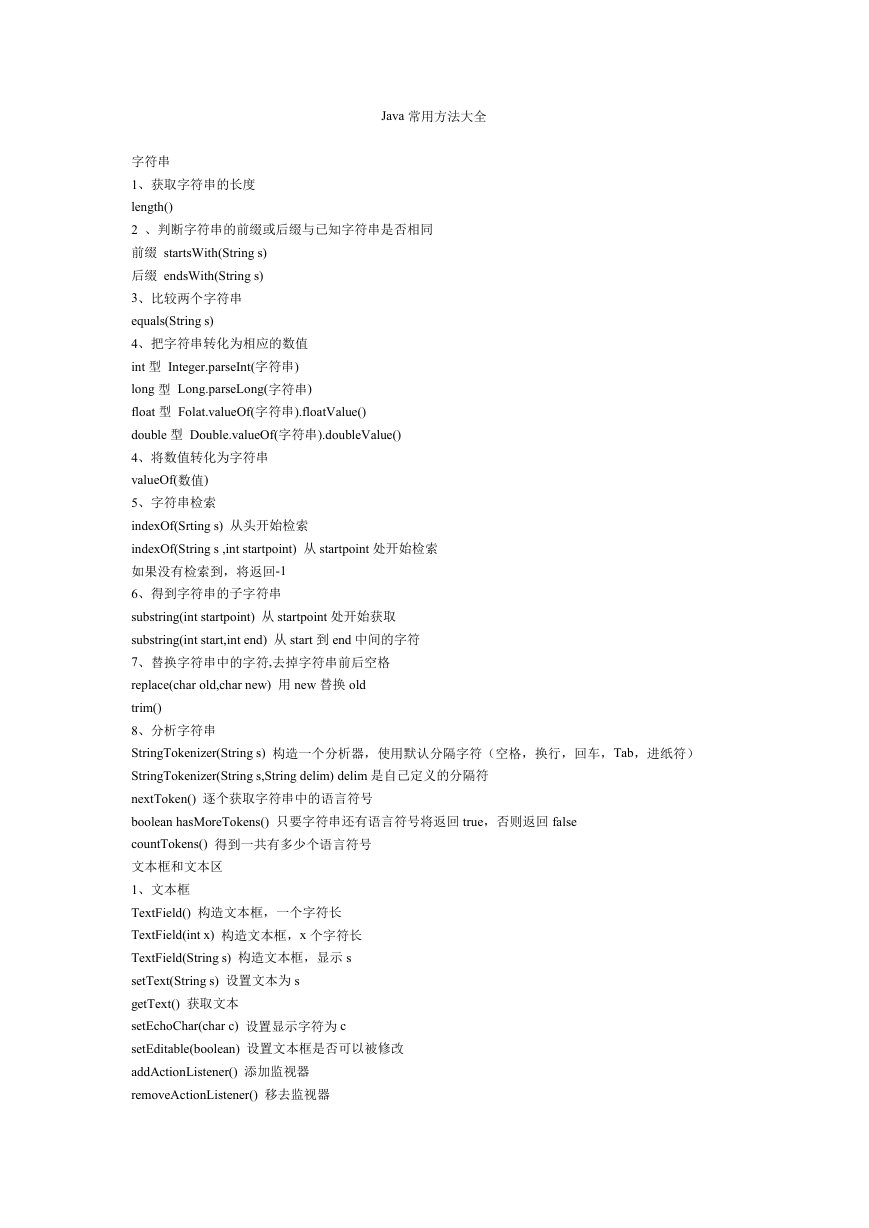
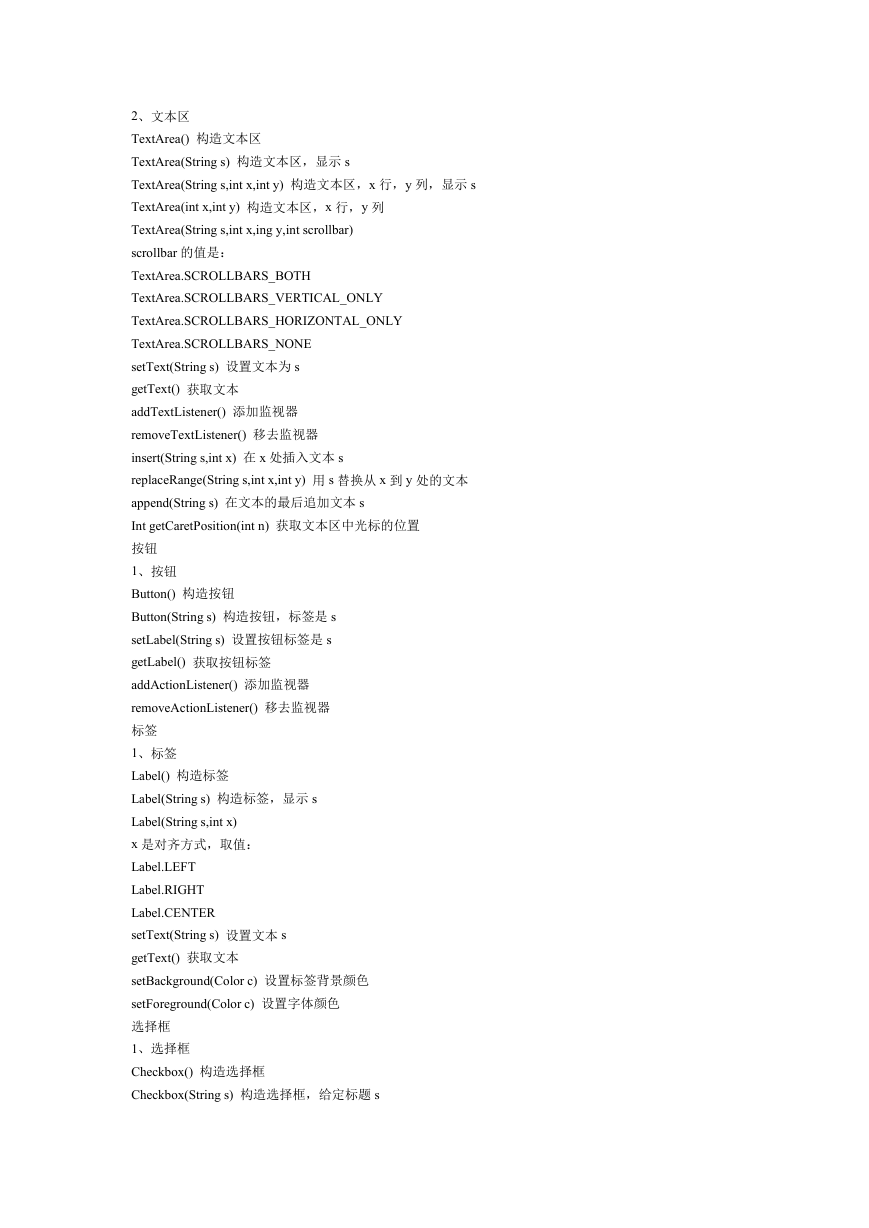
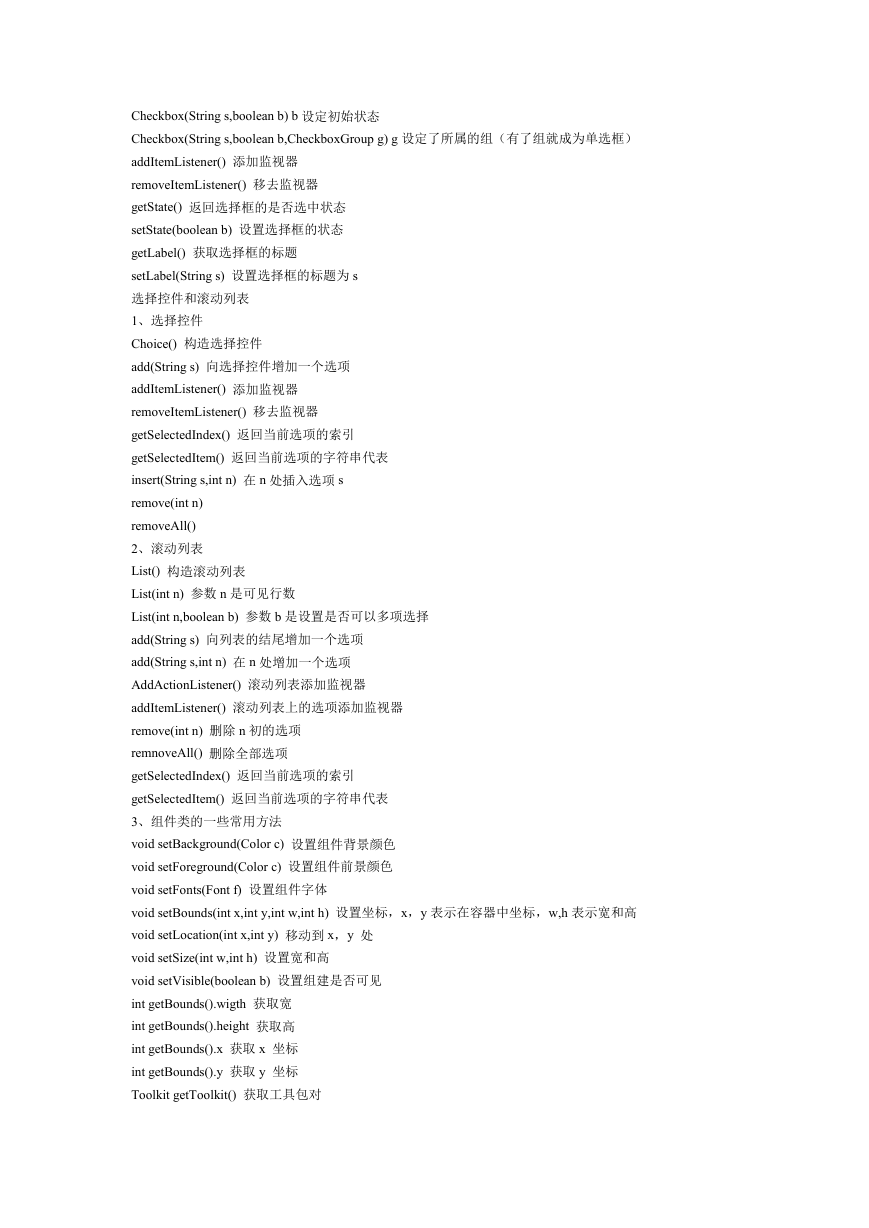
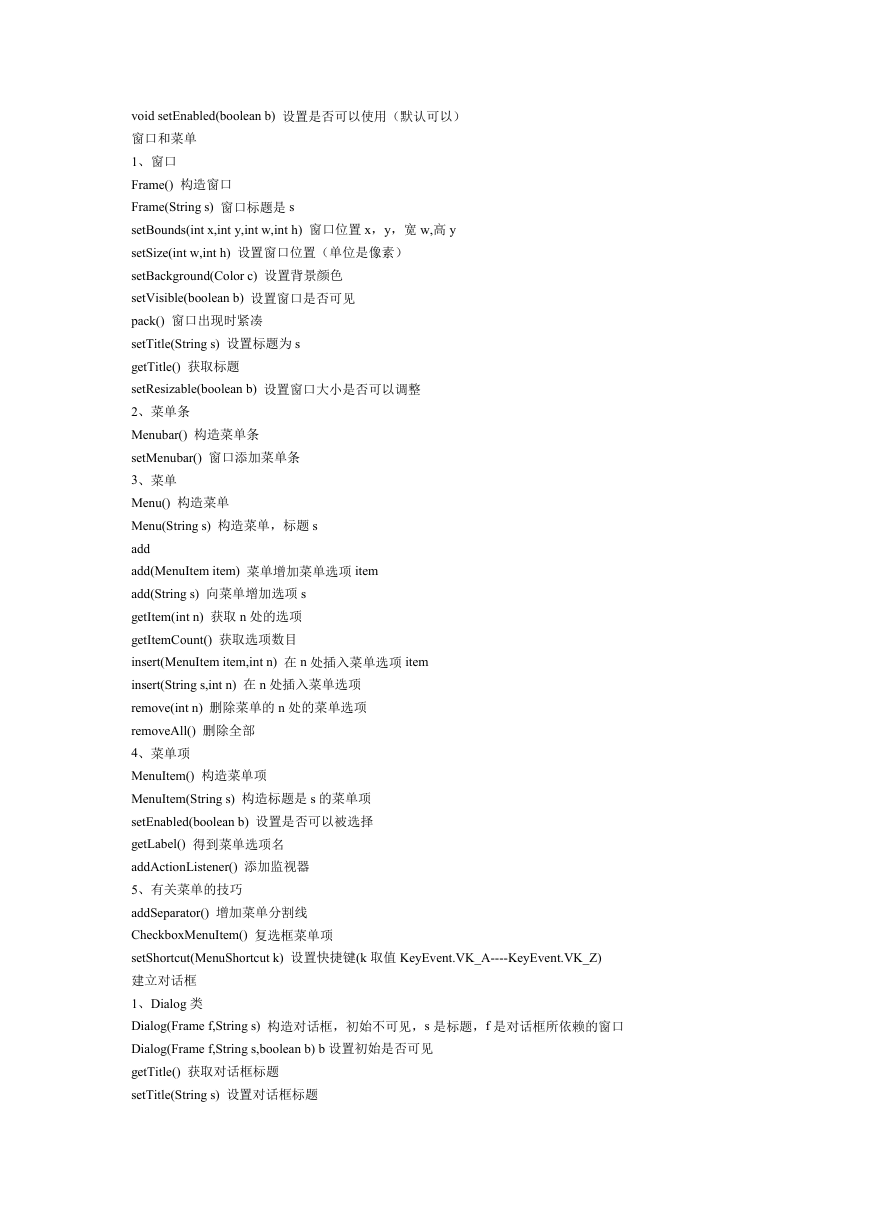
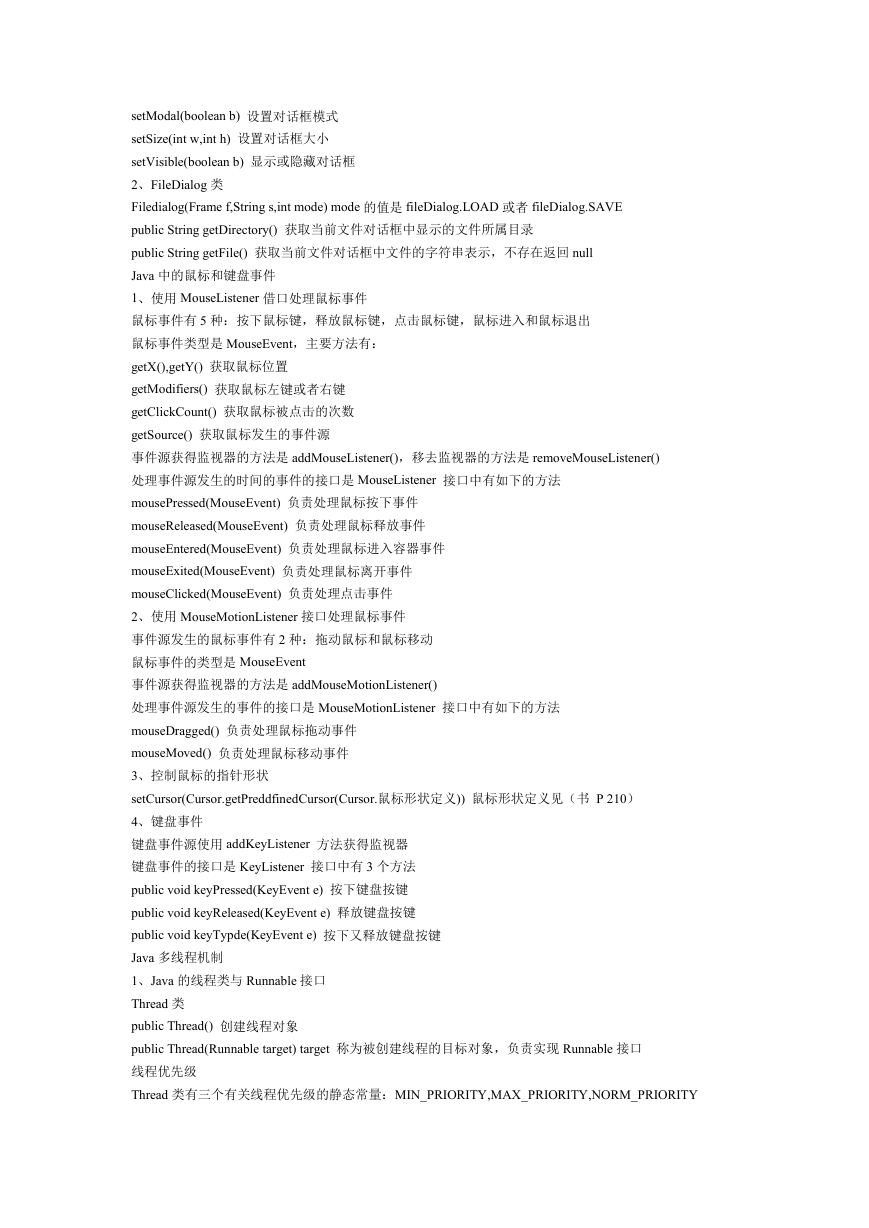
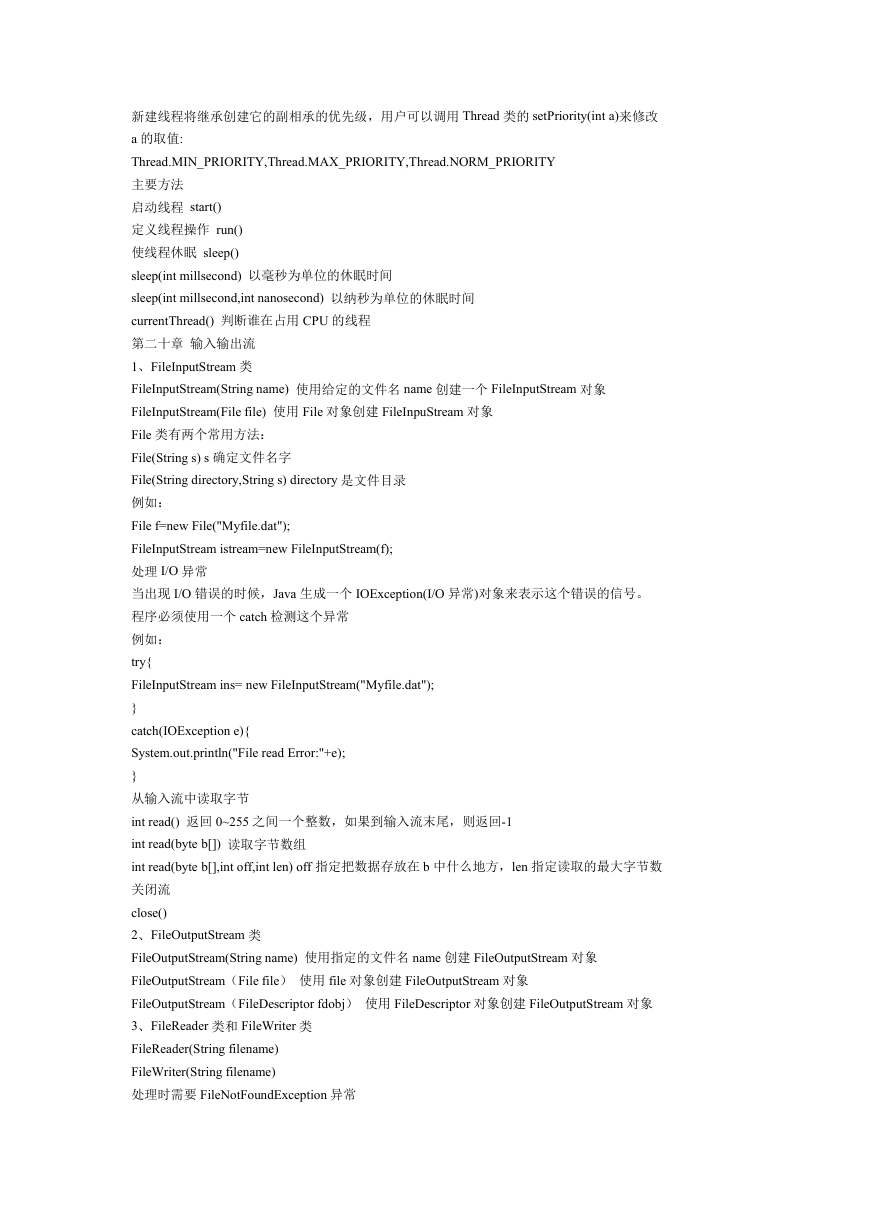
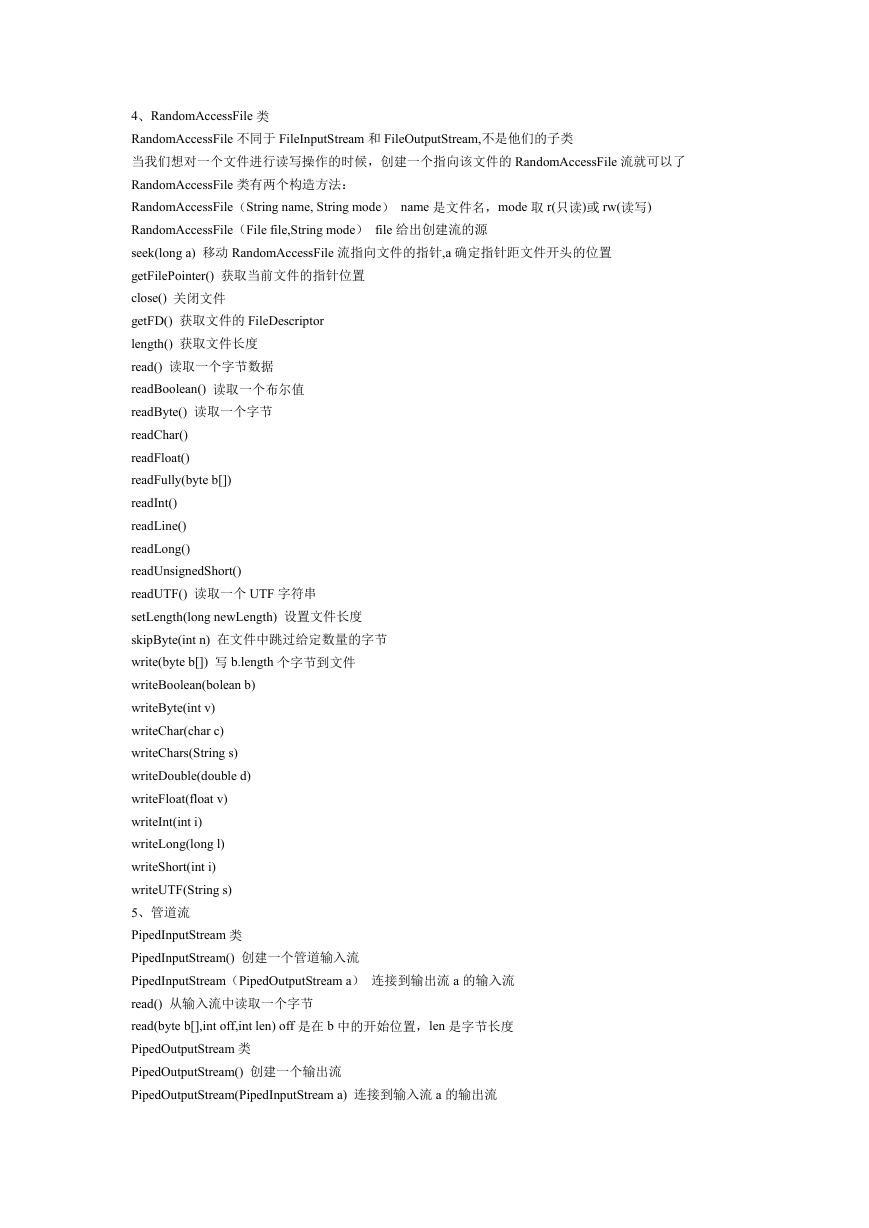
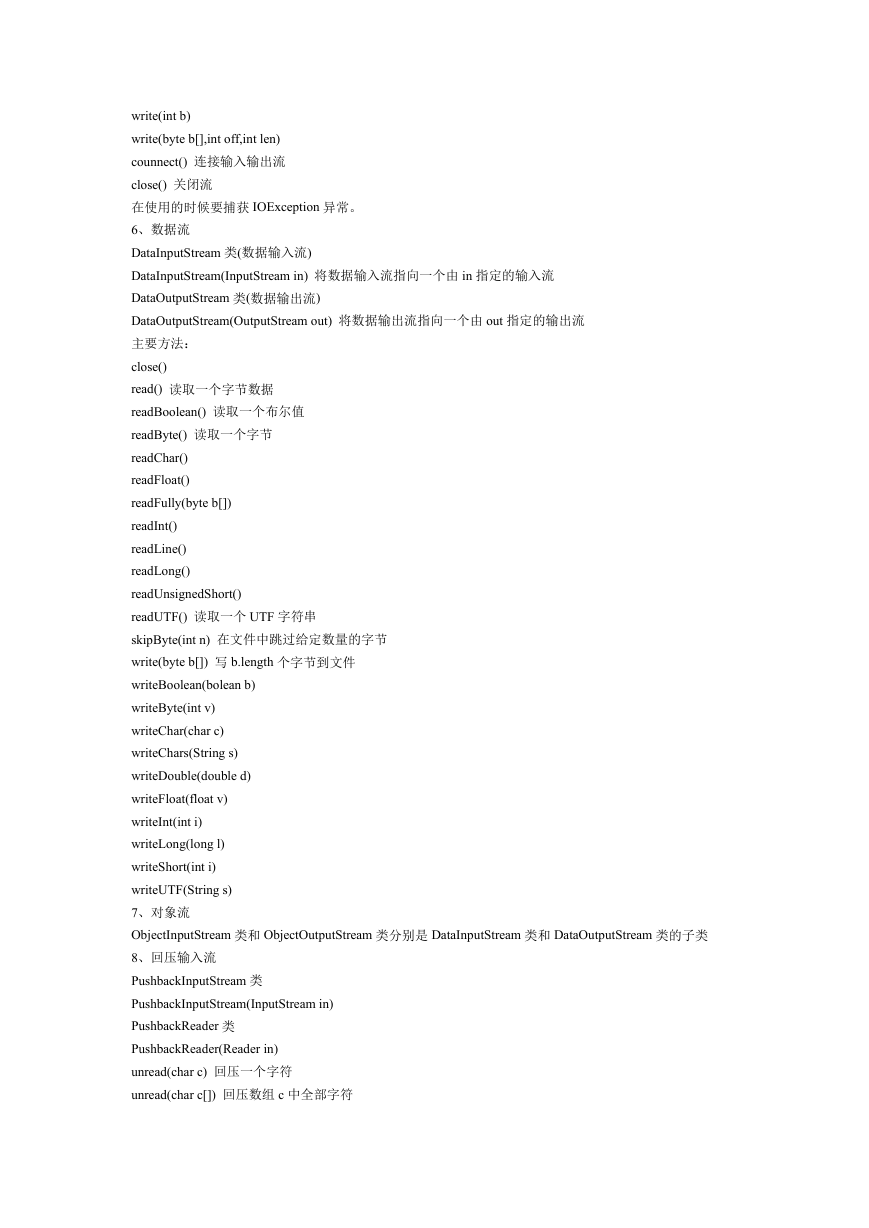








 2023年江西萍乡中考道德与法治真题及答案.doc
2023年江西萍乡中考道德与法治真题及答案.doc 2012年重庆南川中考生物真题及答案.doc
2012年重庆南川中考生物真题及答案.doc 2013年江西师范大学地理学综合及文艺理论基础考研真题.doc
2013年江西师范大学地理学综合及文艺理论基础考研真题.doc 2020年四川甘孜小升初语文真题及答案I卷.doc
2020年四川甘孜小升初语文真题及答案I卷.doc 2020年注册岩土工程师专业基础考试真题及答案.doc
2020年注册岩土工程师专业基础考试真题及答案.doc 2023-2024学年福建省厦门市九年级上学期数学月考试题及答案.doc
2023-2024学年福建省厦门市九年级上学期数学月考试题及答案.doc 2021-2022学年辽宁省沈阳市大东区九年级上学期语文期末试题及答案.doc
2021-2022学年辽宁省沈阳市大东区九年级上学期语文期末试题及答案.doc 2022-2023学年北京东城区初三第一学期物理期末试卷及答案.doc
2022-2023学年北京东城区初三第一学期物理期末试卷及答案.doc 2018上半年江西教师资格初中地理学科知识与教学能力真题及答案.doc
2018上半年江西教师资格初中地理学科知识与教学能力真题及答案.doc 2012年河北国家公务员申论考试真题及答案-省级.doc
2012年河北国家公务员申论考试真题及答案-省级.doc 2020-2021学年江苏省扬州市江都区邵樊片九年级上学期数学第一次质量检测试题及答案.doc
2020-2021学年江苏省扬州市江都区邵樊片九年级上学期数学第一次质量检测试题及答案.doc 2022下半年黑龙江教师资格证中学综合素质真题及答案.doc
2022下半年黑龙江教师资格证中学综合素质真题及答案.doc